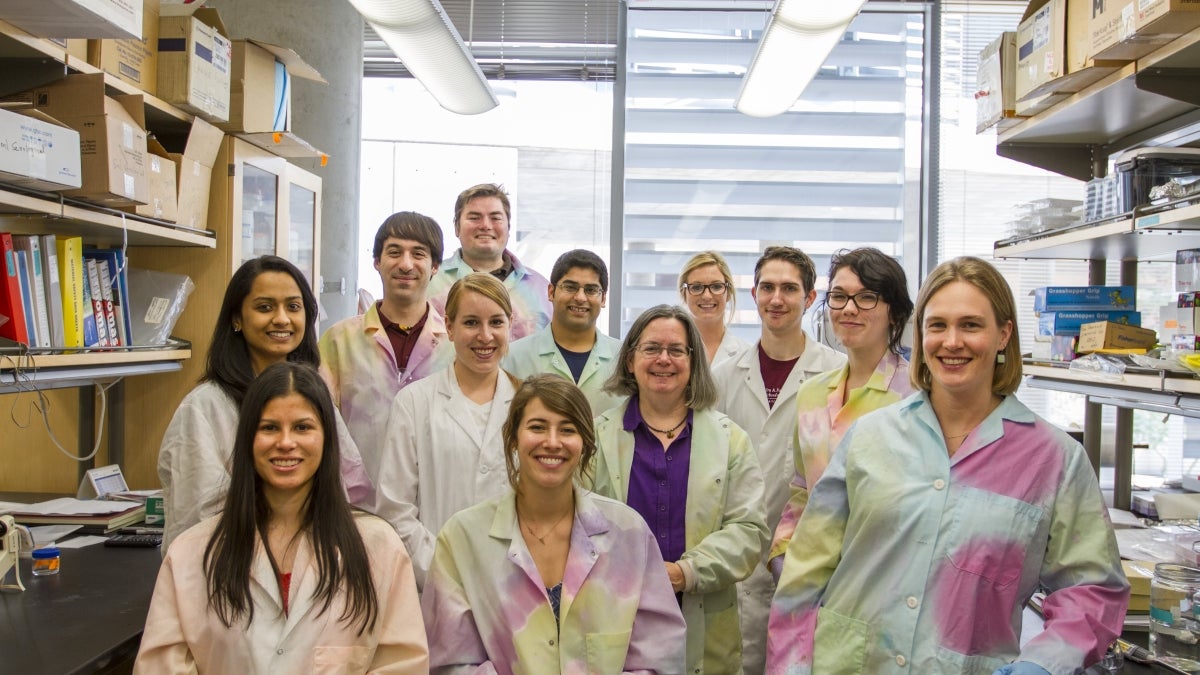ASU biomedical engineer spotlighted as emerging international leader

ASU graduate and undergraduate students are getting valuable research experience in Associate Professor Sarah Stabenfeldt’s lab. Her work on developing new and improved approaches to treating neural injury has been highlighted by a leading international science organization. Photo by Jessica Hochreiter/ASU
Research that promises to speed advances in regenerative medicine is earning Sarah Stabenfeldt international recognition among her professional peers.
Recent editions of two research journals published by the Royal Society of Chemistry spotlight scientists and engineers in the early stages of their careers whom editors consider to be making important contributions to the fields of materials chemistry and biomaterials science.
More than 50 researchers from around the world are featured in those issues of the Journal of Materials Chemistry B and Biomaterials Science.
Stabenfeldt, an associate professor of biomedical engineering in the Ira A. Fulton Schools of Engineering at Arizona State University, is the only one among them with research papers published in the special editions of both journals.
Her work focuses on developing a variety of novel approaches to treat neural injury, primarily traumatic brain injury.
The recent publications in the Royal Society of Chemistry journals describe research by Stabenfeldt and her team of biomedical engineering graduate and undergraduate students to develop and evaluate biodegradable particles used to release small doses of therapeutic proteins to the brain over time. Recent doctoral graduate Dipankar Dutta and current doctoral student Kassondra Hickey played key roles in the projects.
Such therapeutic methods, along with the techniques and tools used to implement them, hold out hope for better ways to diagnose and treat traumatic brain injury and other neurological injuries and traumas.
Peers in the field “envision her research helping to make major advances in unveiling the biological basis of traumatic brain injury, which could save the lives of thousands of patients,” says Mehdi Nikkhah, a fellow Fulton Schools biomedical engineering faculty member.
“Her research approach is grounded in a comprehensive understanding of the mechanisms of disease progression, and her designs for targeted therapeutics utilize some of the most cutting-edge bioengineering-based strategies,” Nikkhah said. “Overall, she is addressing some of our biggest healthcare challenges.”
Stabenfeldt’s research aimed at improving the diagnosis and treatment of traumatic brain injury “could saves the lives of thousands of patients,” says fellow biomedical engineer Mehdi Nikkhah. Photo by Cheman Cuan/ASU
Stabenfeldt earned her doctoral degree in bioengineering from the Georgia Institute of Technology and then conducted research as a National Institutes of Health post-doctoral fellow at Georgia Tech and Emory University.
Since coming to ASU in 2011, she has co-authored more than 20 peer-reviewed articles for research publications — including the particularly prominent journals Nature Materials and Biomaterials — along with three book chapters.
Her work has earned support through an Arizona Biomedical Research Consortium Early Stage Investigator Award, the NIH Director’s New Innovator Award and a National Science Foundation CAREER Award.
Each of these prestigious awards are given to young faculty members who are seen as future research and education leaders in their fields.
“Very few junior faculty members have received more than one of these awards. This achievement undoubtedly places her among those at the forefront of biomedical engineering,” Nikkhah said.
“All of this recognition indicates the significant impact of Sarah’s work to develop next-generation diagnostics and therapeutics for neurological-related disorders such as traumatic brain injury,” said colleague David Brafman, an assistant professor of biomedical engineering in the Fulton Schools, adding that her impact extends beyond the work she is doing in her lab.
“As one of the first female tenured faculty members in our program, Sarah also recognizes the importance of mentoring the next generation,” Brafman said. “Her service as the faculty advisor for the undergraduate Biomedical Engineering Society is one of many ways she has become a positive role model for future biomedical scientists and engineers.”
The Royal Society of Chemistry, based in the United Kingdom, has more than 54,000 members worldwide.
The organization publishes more than 40 peer-reviewed research journals and many books, as well as online databases and literature updating services, covering the core chemical sciences and related fields such as biology, biophysics, energy and environment, engineering, materials, medicine and physics.
Stabenfeldt says being selected to publish in two of the society’s journals highlighting emerging research leaders should boost opportunities for additional support for her projects and possibly generate invitations to present her work at medical science and bioengineering conferences.
Read abstracts of her research papers in the Journal of Materials Chemistry B and Biomaterials Science. At the end of each abstract are links to content from the recent special issues of the journals.
More Science and technology

ASU postdoctoral researcher leads initiative to support graduate student mental health
Olivia Davis had firsthand experience with anxiety and OCD before she entered grad school. Then, during the pandemic and as a…

ASU graduate student researching interplay between family dynamics, ADHD
The symptoms of attention deficit hyperactivity disorder (ADHD) — which include daydreaming, making careless mistakes or taking…

Will this antibiotic work? ASU scientists develop rapid bacterial tests
Bacteria multiply at an astonishing rate, sometimes doubling in number in under four minutes. Imagine a doctor faced with a…
